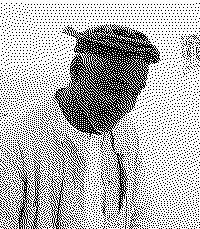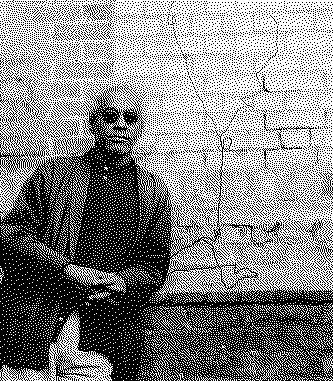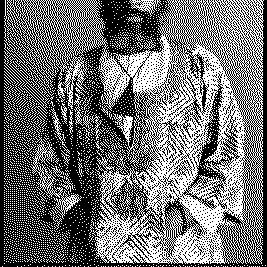Artists/David Hammons
Fast Facts
Use of Everyday and Found Materials
Hammons is known for his innovative use of everyday and found materials, transforming them into profound statements on race, class, and society. His works often incorporate materials such as grease, hair, and discarded objects, highlighting themes of African American life and culture.
Performative Body Prints
In the 1960s and 1970s, Hammons created "body prints" by pressing his greased body onto paper and then dusting the imprint with pigment, merging performance and visual art to explore identity and the black body.
Public and Street Art Interventions
Hammons has engaged in public and street art interventions that challenge conventional gallery spaces and the art market. His temporary and often unannounced public works play with concepts of visibility, accessibility, and the dynamics of public space.
Critique of the Art World
Hammons's art frequently critiques the art world's structures and biases. He has a reputation for being elusive and critical of the commodification of art, often questioning the relationship between art and its commercial and institutional contexts.
Significant Works on African American Experience
Hammons's art powerfully addresses the African American experience, utilizing symbolic materials and imagery to comment on history, culture, and politics. Works like "In the Hood" (1993) use everyday objects to make poignant statements about race and identity in America.
Biography



David Hammons, born in Springfield, Illinois, in 1943, has long stood as a seminal figure in contemporary art, renowned for his provocative works that traverse various mediums while deeply interrogating themes of race, class, societal norms, and the very nature of art itself. Hammons' journey into the art world is a narrative of defiance, innovation, and profound commentary on the African-American experience.
Hammons was the youngest of ten children, raised by a single mother during the challenging times of the 1940s. Despite facing economic hardships, Hammons cultivated an acute awareness of social and racial disparities from an early age. He initially took vocational courses, showing little interest in the academic aspects of schooling, yet demonstrating a natural talent for art—a talent he would later refine and utilize to challenge societal norms and expectations.
In 1962, Hammons left Springfield for Los Angeles, embarking on a transformative period that saw him immerse himself in the city's vibrant cultural and artistic milieu. He attended various institutions, including the Chouinard Art Institute (later CalArts) and the Otis Art Institute, where he was deeply influenced by social realist artist Charles White. White's belief in art as a vehicle for activism and social change resonated with Hammons, embedding in him a lifelong commitment to a socially engaged practice.
Hammons' art is characterized by its use of everyday objects, transforming them into powerful symbols and commentary on race, identity, and societal structures. His work in the 1970s and beyond often incorporated found materials—ranging from hair collected from barber shops to discarded bottles and elephant dung—into sculptures and installations that challenged conventional notions of beauty, value, and meaning in art. Notably, his African-American Flag and other pieces utilizing the flag motif interrogate national identity and representation, while works like Hair Relaxer explore themes of beauty, identity, and cultural practices within the African-American community.
Throughout his career, Hammons has maintained a critical stance towards the art establishment, often employing humor and subversion to critique the commercialization of art and the commodification of the Black body and identity. His performances and installations frequently incorporate elements of Dadaism and Arte Povera, emphasizing the process and concept over the finished product.
By the late 20th and early 21st centuries, Hammons' work had gained significant recognition, leading to prestigious awards and his art being showcased in major institutions worldwide. Despite this acclaim, Hammons has remained an elusive figure, wary of the art market and steadfast in his commitment to art as a means of social commentary and transformation.
In recent years, his public installations, such as Day's End—a ghost monument to artist Gordon Matta-Clark—continue to reflect his interest in history, memory, and the urban experience. Through a career that spans over five decades, Hammons has remained a critical voice, using art to challenge, question, and inspire (Wikipedia) (The Art Story) (Studio Museum in Harlem).
Importance
David Hammons' significance in the contemporary art world is deeply rooted in his innovative approach, critical commentary on African American life, and his defiance of the commercial art market.
Innovative Use of Materials and Found Objects
Hammons has been recognized for his distinctive use of materials and found objects, turning everyday items into profound statements on race, culture, and society. Starting with his Body Prints in the late 1960s, Hammons created X-ray-like figures using his own body, which were later complemented by sculptures made from urban detritus such as hair from barbershops, chicken bones, bottle caps, and empty liquor bottles. These works critique stereotypes and societal expectations placed upon African Americans (The Museum of Modern Art).
Critical Engagement with African American Culture and Social Issues
Through his work, Hammons has consistently engaged with themes central to the African American experience. For example, his piece Higher Goals critiques the notion of basketball as a realistic pathway to success for African American youth, highlighting the broader societal issues of education and opportunity (The Art Story). His work How Ya Like Me Now directly addresses the issue of racism in American politics and culture, challenging perceptions and inviting critical discourse (The Art Story).
Subversion of Artistic and Cultural Expectations
Hammons' career is marked by a tactical evasion of the art world's expectations and norms. He has often operated outside the conventional spaces of the art market, engaging in performances and creating works that challenge the commodification of art. His Bliz-aard Ball Sale, where he sold snowballs on a New York street, is a poignant example of his critique of the art market and its exclusionary practices (Something Curated).
Influence and Legacy
Despite—or perhaps because of—his evasive relationship with the art establishment, Hammons has had a profound impact on contemporary art. His work inspires discussions about the role of the artist, the value of art beyond commercial metrics, and the power of art to critique and engage with societal issues. Through his unique blend of humor, provocation, and poignant critique, Hammons has influenced generations of artists and continues to be a vital voice in conversations about art, race, and identity (The Museum of Modern Art) (Something Curated).
Technique
David Hammons' technique in art is marked by a unique approach to materials, thematic exploration, and a critical engagement with cultural and social issues, particularly those affecting African American communities.
Body Prints (1968–1979)
Hammons pioneered a method of creating artwork using his own body as a printing tool. By applying grease (such as margarine or baby oil) to his skin and then pressing his body against paper, he was able to leave an impression, which he then dusted with powdered pigments such as charcoal, creating detailed, x-ray-like images that capture the texture of skin and hair. These body prints serve as a direct index of the human form, offering both a personal and political commentary on identity, race, and existence (Flash Art) (The Drawing Center).
Use of Found Objects
After moving to New York in 1974, Hammons expanded his repertoire to include sculptures and installations made from materials collected from urban environments, such as hair from barbershop floors, chicken bones, bottle caps, and liquor bottles. These materials were transformed into profound critiques of societal expectations, racial stereotypes, and cultural clichés, exemplifying his skill in elevating everyday objects into the realm of high art (The Museum of Modern Art).
Public Installations and Performative Acts
Hammons' work often extends into public spaces and involves elements of performance. Notable examples include his Bliz-aard Ball Sale, where he sold snowballs of varying sizes on a New York City sidewalk, and his towering basketball hoops installations, which comment on racial and socioeconomic dynamics within American culture (The Museum of Modern Art).
Critical and Conceptual Engagement
Hammons' art is deeply rooted in conceptual art practices, employing irony, satire, and poignancy to challenge viewers' perceptions. His work engages with themes of invisibility, cultural appropriation, and the commercialization of art, often requiring viewers to confront their own biases and assumptions (Hauser & Wirth).
Abstract and Mixed Media Works
In works such as his Untitled (Kool-Aid Drawing), Hammons employs unconventional materials like Kool-Aid powder to create vibrant compositions that critique the commercial art world and explore themes of visibility, access, and the valuation of art. This piece, which can be covered by a silk cloth, blurs the line between sculpture and drawing, emphasizing the performative aspect of viewing art (Hauser & Wirth).













